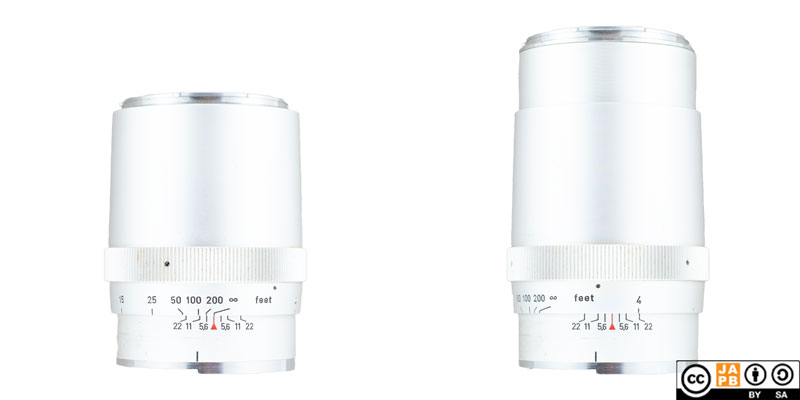Pekka Buttler, 01/2025

Specifications
The table below summarizes the lens’ key specifications (Measurements based on pictured sample):
| Brand: | Carl Zeiss | Lens name | Sonnar 1:4 f=135 mm |
| Focal length(s)1 1 | 135 mm | Angle-of-view 2 | 18° |
| Maximum Aperture | f/4 | In Production | 1958–1970 |
| Lens mounts | Contarex | Subfamily (if applicable) | –– |
| Length 3 | 86,2 mm | Diameter 4 | 65,0 mm |
| Filter ring diameter | 49 mm | Weight | 529 grams |
| Lens element count | 4 | Lens group count | 3 |
| Aperture blades (S/R/C) 5 | 9 S | Focus throw | 170 ° |
| Minimum focusing distance | 1,2 cms | Maximum magnification | 1:6,7 |
| Has manual aperture ring | NO | Has Manual focus ring | YES |
| Aperture mechanism type | N/A | Aperture click stops | N/A |
Further notes:
• This lens is Zeiss’ most affordable Tele lens for the Contarex system.
• Being a lens for the Contarex mount, the lens lacks an aperture ring (the Contarex system controlled the lens’ aperture from the camera). This has some implications on adapting (see below).
• The lens is available both in a Silver finish (pictured) as well as in a mostly black finish
• As with other Carl Zeiss’ Contarex lenses, this lens sports a front bayonet for attaching lens hoods, custom filters and lens caps.
• Alternatively, you can use the 49 mm threads to mount an aftermarket lens hood or generic filters.

Right: Carl Zeiss Sonnar 135 mm f/4 focused at MFD
Versions
The Carl Zeiss Sonnar 135 mm f/4 for Contarex mount was manufactured in silver and black finish, but I have no indication of a a significant optical redesign having taken place within the lens’ life-span.
Adapting
If you’re lucky enough to have a functional Contarex camera body I recommend you put some film into it to get the experience of using the lenses in their original intended environment. Even so, given the deserved reputation of Contarex cameras to be difficult to maintain in working order, you’re more likely to have some working Contarex lenses (the lenses were well-designed and rugged) than a working Contarex body.
Should you want to use Contarex lenses adapted to another system, one key requirement toward such an adapter would be that it allows the adapter to manipulate the inner aperture control ring (see image above) of the Contarex lens.
It is precisely the requirement to allow the manipulation of the lens’ aperture which makes it almost impossible to manufacture an adapter that would allow using Contarex lenses on dSLRs. Even though the flange focal distance of the Contarex mount is 46 mm, the 2 mm difference between Canon EF and Contarex is insufficient for manufacturing an adapter that would allow using Contarex lenses (with aperture adjustment) on Canon EF cameras. But I did say ‘almost’ because the (original) Four Thirds lens mount did give adapter builders enough leeway to construct a fully functional adapter (many just today tend to forget the Four Thirds mount).
On the other hand, should you intend to adapt Contarex lenses to mirrorless cameras, the only requirement is finding an adapter that allows manipulation of the Contarex’ (rather unusual) aperture setting system. As of this writing, such adapters exist for basically all mainstream mirrorless mounts.
Background of why Contarex lenses are as they are
If you’re interested in how come there exists such an odd, different and attractive lens as Contarex lenses are, feel free to study the JAPB article on the Contarex lens mount.
Footnotes
- Focal length is (unless stated otherwise) given in absolute terms, and not in Full-frame equivalent. For an understanding of whether the lens is wide/tele, see ‘Angle-of-view’. ↩︎
- Picture angle is given in degrees (based on manufacturers’ specs) and concerns the diagonal picture angle. Rule of thumb:
> 90 ° ==> Ultra-wide-angle
70–90 ° ==> Wide-angle
50–70 ° ==> Moderate wide-angle
40–50 ° ==> ‘Standard’ or ‘normal’ lens
20–40 ° ==> Short tele lens
10-20 ° ==> Tele lens
5-10 ° ==> Long tele lens
< 5 ° ==> Ultra-tele lens ↩︎ - Length is given from the mount flange to the front of lens at infinity. ↩︎
- Diameter excludes protrusions such as rabbit ears or stop-down levers. ↩︎
- S=straight; R=rounded; C=(almost)circular at all apertures. ↩︎